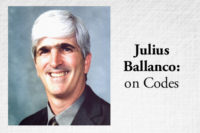The updating of the 2018 Uniform Plumbing Code and Uniform Mechanical Code started the first week of May in Denver.
There were 350 code changes proposed to the UPC and 290 code changes proposed to the UMC. By comparison to previous meetings, the IAPMO code hearings were lightly attended. However, that didn’t stop the normal banter that goes on during discussions of proposed changes.
The plumbing hearings started off with discussions on the way the code will change regarding the referencing of standards. For as long as I can remember, referencing plumbing standards has been a sore point for many of the contractors that participate on the code. However, the IAPMO hierarchy developed a protocol that the technical committees are required to follow. Only standards referenced in the body of the code are permitted to be included in the primary referenced standard table. A second table was developed that lists other plumbing-related standards and documents. However, they only can be used when seeking an alternative approval.
This change in philosophy, which is wonderful, required a number of standards to be added to the body of the code. There were more than 100 code changes just on adding standards to various sections of the code. This allowed the standards to remain in the primary reference table.
Many of the proposed fixture changes fell into the standard update category. However, the issue of availability of fixtures brought new light to the question of facilities for use by transgender individuals. With all the recent headlines, the code change proposed by the Transgender Law Center brought about a lot of discussion. The concept was to require all single-occupant toilet rooms to be marked as being available to either sex. Some questioned how this impacts transgender people.
While the term “transgender” was used, the proponent did a good job of explaining that the available use of single-occupant toilet rooms will reduce waiting time if there is a longer line in the women’s room than the men’s room. The wait would be the same.
The code change was eventually rejected because some of the proposed language did not make sense when looking at the overall intent of the proponent. In order to properly address the issue, a committee proposal was developed. The IAPMO procedures allow the Technical Committee to formulate a code change during the first meeting to review code changes. As such, the committee developed a change that would require all single-occupant toilet rooms to have signage that indicates use by either sex. That proposal was recommended for approval.
Hot topics
The two other main matters in the fixtures section were hot water and water conservation. The water conservation proposed changes dovetailed the new California water conservation requirements. Shower flow rates would drop to 2 gpm, lavatories would drop to 1.5 gpm and water closets would drop to 1.28 gpf.
Similar proposals were rejected by the International Plumbing Code Committee. There was some thought that the IAPMO Committee would approve the changes since it is the plumbing code used in California. Furthermore, there are a number of people on the committee from California. That didn’t seem to matter; all the water conservation code changes were recommended for rejection.
The hot water proposals went in two different directions. There was a series of code changes that proposed to raise certain water temperatures in an effort to control Legionella. The other series of code changes were proposed to reduce scalding potential.
The Legionella code changes all were rejected since they were not well-coordinated, nor were there adequate justification for adding the requirements to the code. The changes also only addressed one contaminant in the drinking water, whereas there is the possibility of many additional contaminants that were not addressed.
The hot water proposals appeared to be a “belts and suspenders” approach. The UPC already has a complete set of requirements for protecting against scalding. The changes would require additional valves to be provided at the water heater. There also were added provisions for scald protection to lavatories and kitchen faucets. These changes were not technically supported since lavatory and kitchen faucets allow the user to quickly withdraw their hands with minimal burning potential. All these changes were recommended for rejection.
Sizing it up
Under the water pipe sizing, two significant changes were proposed. The first change was to the sizing method that appears in Chapter 6. Most plumbing engineers tend to ignore this sizing method with the exception of smaller systems. I will admit I was confused when I first read the change, but once you analyze the reason statement, the change to the sizing made perfect sense.
What had often been occurring is overall water supply fixture unit values were being added to both the hot and cold water side of the system. However, the table says to only use 75% of the value for the hot side and the cold side when sizing the separate systems. When the water piping reaches the point before the water heater, all the fixture unit values have to be further adjusted, applying only the single value for sizing the cold water supply.
Once it was clear what this code change was trying to accomplish, it was recommended for approval.
The other water sizing change would add a new appendix for sizing the water supply to dwelling units using low-flow fixtures. The sizing method would be another available option for sizing the water distribution system.
One of the complaints was that you would need to be an engineer to use this methodology. Since engineering the sizing is already permitted, some questioned why the method should be added to the code.
After looking at the overall approach, the method was good for sizing standard dwelling units. A standard dwelling unit has two to three bathrooms. Once you add a fourth, fifth or sixth bathroom, the new method actually oversizes the piping. Of course, oversizing is better than undersizing.
The proponent indicated the water sizing method was based on a peer-reviewed unpublished paper. The problem was the paper was not provided to the Technical Committee. There was no way to evaluate the sizing method without the paper. In the end, the code change was rejected based on the fact the unpublished paper was not provided to the Technical Committee.
Next month I’ll review the drainage, venting and storm drainage proposed changes. If you would like to download a copy of the monograph for the UPC and UMC, go to http://kavi.iapmo.org.
This article was originally titled “Let the updating begin” in the June 2016 print edition PM Engineer.




